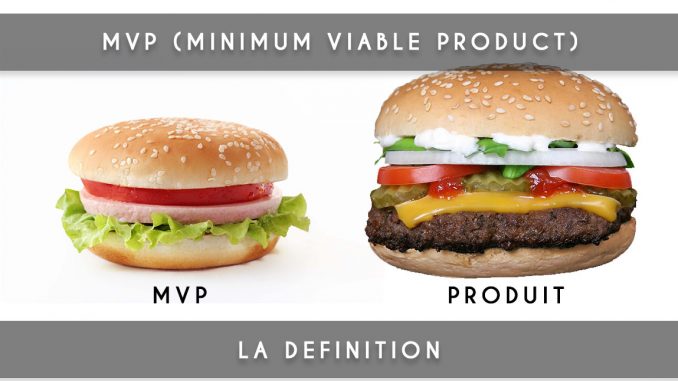
MVP agile : Minimum Viable Product
I purpose a quick little definition of a word that appears more and more in Agile project management: the MVP. The meaning of this acronym is Minimum Viable Product.
Story of the agile MVP
The MVP is popularized by Eric Ries’ book The Lean Startup. The idea was to define the minimum that the product would propose to answer a problem and to verify that our answer is correct.
MVP meaning
Making an MVP makes a lot of sense when you want to make a new product because it can quickly be expensive. This is even more true when we want to create a company with an idea when we are first on the market. To be the first is often a sign that the product will not interest peoples; but a lot of contractors want to try the market when he’s persuaded to have the next “Uber” in his hands.
The Mimimum Viable Product will create a cheaper product that will contain the minimum necessary to test future users. We are far from the final product but we can validate (or conversely) that our product responds well to a market demand.
A product under the MVP is not necessarily an application. We must not confuse the MVP and the MMP (Minimum Markable Product), a notion that we will see later.
We will see examples that will allow you to understand the subtlety.
Examples of MVP
The blog Myagile Partner
For this blog, I had defined an MVP but at this time, I am very far from the final product that I want to have. However this allows me to judge the market and see if it is good or not to continue investing in this blog.
Here is what problem wanted to answer this blog:
“Find help to evolve in the world of agility and find practices that I could implement”
Here is the MVP of my site. However, I want to do more but I prefer to do things at the right time: video tutorials, complete tutorial pages, a totally harmonized design …
The evolution of this blog will be according to the evolutions of the requests. For example, the previous month, I have created a repository to respond to a new request:
“How to find this practice on the blog? “
Dropbox made a video in MVP
As I said, the MVP is not necessarily an application. Let’s see the Dropbox case.
The founder of Dropbox didn’t not convince investors to give money in this umpteenth file sharing system. However he was desperately trying to make them understand that his application was different: it was the only one of the market that is transparent in its backup operation and it would be the revolution of this type of application.
He finally made the decision to present his solution in video which was a real success with users. In a few days, 75,000 people registered for the Beta version.
And, this video was the MVP that was not an application. Today, Dropbox is the largest company in San Francisco.
My MVP is not a risk of failure?
It is true that we are talking about MVP every day but never fail. The MVP really aims to define the minimum that will offer the solution to potential users. If you think that your minimal product is the cause of the failure, maybe that your MVP was not good.
It is not so simple to define an MVP, you will have to do it very seriously.
How to create my MVP
In order to try to make a good MVP, here is a recognized method that will allow you to properly build your MVP.
1/ Analyze the product market
Logically, before the creation of your startup or your new product, you have already done a market analyze. Now, enjoy your analyze or do it if you have forgotten this step to define what your product needs to present to customers.
It is often interesting not to be like the others and therefore to see what could really differentiate you from the competition; if you launch a product that is the same than the others with less functionalities, it will be difficult to sell you.
2/ Learning about your users
To make a good MVP, start by understanding your customers. Do not be afraid to meet them, brainstorm with them if they want to participate.
They are the ones who will know best to inform you so it is essential to do this step. I regularly see products being made without the presence of an end user; you are not the end user … It’s a mistake that I see regularly: we think we are customers and we make our remarks …
The real customers are the source of your future success, meet them. Do not take their place because you are not in their place.
3/ Define the final product
Using brainstorming or a shared document for example, you could define with all the people related to the project, the functionalities that will define the final product. You will have a relatively consistent list.
4/ Define the list of MVP features
From the complete list that defines the final product and with the help of your users’ feedback in the second step, take only the features that are required in the first version of your product.
We agree that the features we didn’t select at this step will be developed for the final product; this functionalities will arrive much later than the MVP.
Some companies took advantage of the Minimum Viable Product to review the copy of the final product because they found behaviors surprisingly different from those expected.
5/ MVP presentation support
To launch your Minimum Viable Product, you can make a prototype (the most classic case) but also a video or accept that a part of the process is manual.
Conclusion – What is MVP?
In the process of Lean Startup, the MVP can even allow to review its functionalities along the way. The Minimum Viable Product is really an interesting approach to create a new product or great features that I advise you to follow.
We see this practice more and more used in Agile. It can bring a lot to the progress of the projects. Feel free to tell us in comment the gains or faults you have experienced with this increasingly popular practice.




2 Trackbacks / Pingbacks